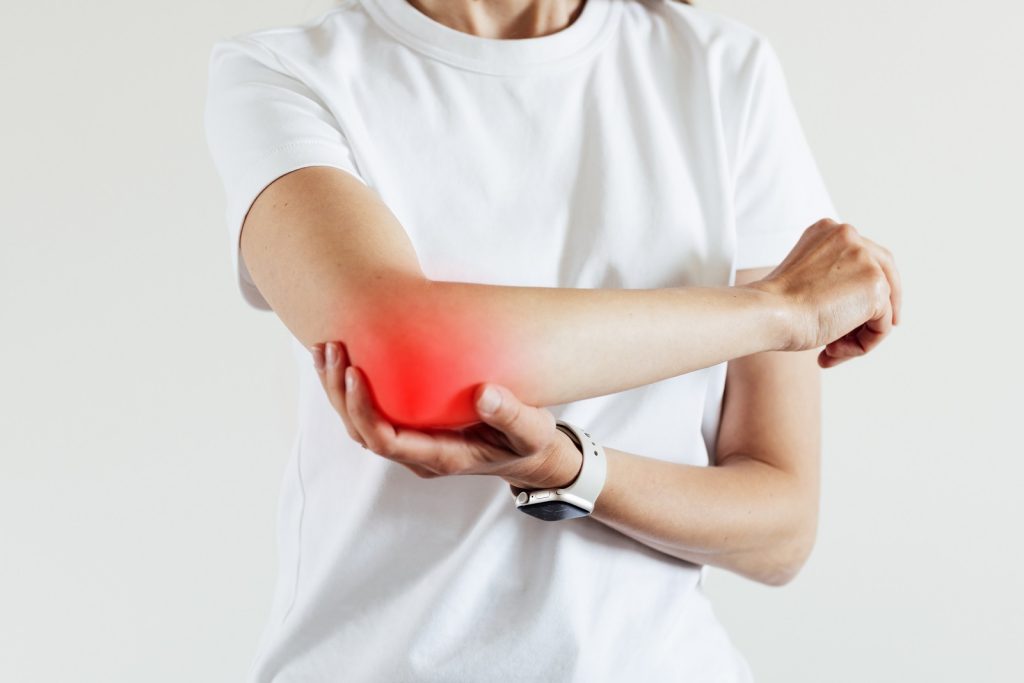Elbow Pain
Elbow pain is a common condition that can affect people of all ages and activity levels. The elbow is a complex joint formed by the meeting of three bones: the humerus (upper arm bone), and the radius and ulna (forearm bones). Pain in the elbow can be due to a variety of causes, ranging from acute injuries to chronic conditions, and can significantly impact daily activities and quality of life.
Common Causes of Elbow Pain
Elbow pain can arise from various sources, including:
- Tennis Elbow (Lateral Epicondylitis): Caused by repetitive stress and overuse, especially in activities that involve gripping and lifting. It results in pain on the outside of the elbow.
- Golfer’s Elbow (Medial Epicondylitis): Similar to tennis elbow but affects the inner part of the elbow, caused by repetitive wrist and forearm motions.
- Bursitis: Inflammation of the bursae, the small fluid-filled sacs that cushion the elbow joint, often due to prolonged pressure or repetitive motion.
- Arthritis: Both osteoarthritis and rheumatoid arthritis can cause elbow pain, leading to joint inflammation, stiffness, and reduced mobility.
- Fractures and Dislocations: Trauma from falls, accidents, or sports injuries can result in broken bones or dislocated joints, causing severe pain and swelling.
- Nerve Compression: Conditions such as cubital tunnel syndrome, where the ulnar nerve is compressed, can lead to pain, numbness, and tingling in the elbow and forearm.

Symptoms of Elbow Pain
Elbow pain can manifest in various ways, depending on the underlying cause. Here are the common symptoms associated with elbow pain:
- Localized Pain: One of the hallmark symptoms of elbow pain is discomfort in or around the elbow joint itself. This pain can vary in intensity and may present as sharp, dull, or throbbing. It can be exacerbated by movement or pressure on the affected area.
- Swelling: Inflammation and swelling are common features of many elbow conditions. Visible swelling around the elbow joint may indicate fluid accumulation or tissue inflammation, often accompanied by warmth and redness in the affected area.
- Stiffness: Elbow stiffness can make it challenging to bend or straighten the arm fully. Reduced range of motion in the elbow joint may occur due to inflammation, muscle tightness, or structural abnormalities within the joint.
- Weakness: Elbow pain can lead to weakness in the forearm and hand muscles. This weakness may affect grip strength and fine motor skills, making tasks like lifting objects or performing everyday activities more difficult.
- Numbness or Tingling: In cases where nerve compression is involved, individuals may experience sensations of numbness, tingling, or “pins and needles” in the forearm, hand, or fingers. This can occur when nerves in the elbow region are compressed or irritated, leading to altered sensation along their distribution pathways.
Diagnosis of Elbow Pain
Diagnosing the cause of elbow pain requires a comprehensive assessment to identify the underlying condition accurately. The diagnostic process typically involves:
- Physical Examination: A thorough evaluation of the elbow joint, including assessment of range of motion, tenderness, swelling, and muscle strength. The healthcare provider may perform specific maneuvers to reproduce symptoms or identify areas of localized discomfort.
- Medical History: A detailed discussion of the patient’s symptoms, medical history, activity levels, and any recent injuries or traumas. Understanding the onset, duration, and aggravating factors of the elbow pain is essential for determining the underlying cause.
- Imaging Tests: Diagnostic imaging techniques such as X-rays, MRI (Magnetic Resonance Imaging), or CT (Computed Tomography) scans may be ordered to obtain detailed images of the bones, joints, and soft tissues in the elbow region. These imaging studies help identify fractures, dislocations, arthritis, soft tissue injuries, or structural abnormalities that may be contributing to the elbow pain.
- Nerve Tests: In cases where nerve compression or damage is suspected, nerve conduction studies or electromyography (EMG) may be performed to assess nerve function. These tests evaluate the electrical activity of muscles and the conduction of nerve impulses, helping to identify nerve-related issues such as cubital tunnel syndrome or radial nerve entrapment.
Treatment Options for Elbow Pain
The treatment approach for elbow pain varies depending on the underlying cause and the severity of the condition. Here are some common treatment options:
- Rest and Activity Modification: Avoiding activities that aggravate the pain and giving the elbow adequate rest can help promote healing. Limiting repetitive motions and heavy lifting can prevent further strain on the elbow joint.
- Physical Therapy: A structured physical therapy program can play a crucial role in managing elbow pain. Physical therapists can prescribe specific exercises to strengthen the muscles around the elbow, improve flexibility, and enhance range of motion. Manual therapy techniques may also be employed to alleviate stiffness and promote tissue healing.
- Medications: Over-the-counter pain relievers such as acetaminophen or nonsteroidal anti-inflammatory drugs (NSAIDs) like ibuprofen can help reduce pain and inflammation associated with elbow conditions. In some cases, corticosteroid injections may be administered directly into the affected area to provide targeted relief of pain and inflammation.
- Bracing or Splinting: Using braces, splints, or elbow supports can help immobilize the joint and provide stability during activities. This can help alleviate pain and facilitate healing, particularly in cases of acute injury or conditions like tennis elbow or golfer’s elbow.
- Surgery: In severe or refractory cases of elbow pain, surgical intervention may be necessary. Surgical procedures vary depending on the underlying condition and may involve repairing damaged tissues, removing loose bodies or bone spurs, or releasing compressed nerves. Surgical options are typically considered when conservative treatments have failed to provide adequate relief or when there is significant structural damage requiring surgical correction.
Preventive Measures
To prevent elbow pain:
- Proper Technique: Using correct techniques in sports and daily activities to avoid overuse injuries.
- Strengthening Exercises: Regularly performing exercises to strengthen the muscles around the elbow and forearm.
- Ergonomic Adjustments: Ensuring that workstations and tools are ergonomically designed to reduce strain on the elbow.
- Gradual Increase in Activity: Gradually increasing the intensity of physical activities to prevent sudden strain on the elbow.
When to See a Doctor
If you experience persistent elbow pain, swelling, numbness, or difficulty moving your elbow, it is important to seek medical advice. Early diagnosis and treatment can prevent further complications and help you return to your normal activities.

Contact Us
If you’re experiencing elbow pain and seeking expert guidance and treatment, we invite you to schedule a consultation with Dr. Burhan. With extensive experience in orthopedic care and a compassionate approach to patient needs, Dr. Burhan is dedicated to providing personalized solutions to alleviate your discomfort and improve your quality of life. Take the first step toward relief and recovery by reaching out to us today.


